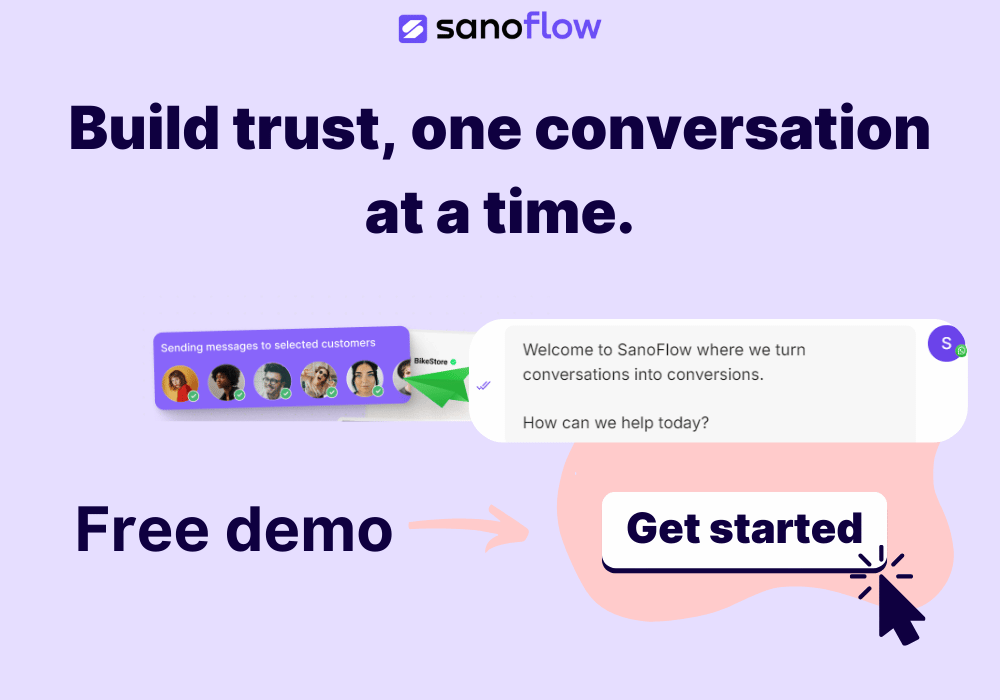WhatsApp has become a key communication tool for many businesses. With its potential to reach customers quickly, businesses need to make the most of this platform. A great way to do this is through WhatsApp segmentation. Segmentation involves grouping your audience based on certain criteria, which helps in tailoring messages that resonate with them. This approach caters to individual needs and preferences, making it more likely for your messages to get noticed and replied to. By focusing on how people interact with your content, you can craft messages that are both relevant and engaging.
Positioning your business’s communication strategy around segmentation can make a significant difference in connection and engagement. This not only helps in streamlining communication but also in maximizing the chances of a response. WhatsApp engagement platforms, like Sanoflow, aim to simplify this process by offering handy tools that assist in segmenting your audience effectively. This ensures conversations are more personalized, leading to increased reply rates and better overall customer engagement.
Segmenting by Intent
Breaking down your audience based on intent is an efficient way to fine-tune your communication strategy. Intent refers to the purpose or goal behind each user’s interaction with your business. For example, some users may be exploring your products, while others may be closer to making a purchase. By figuring out where each user stands, you can send messages tailored to their situation, which increases the chances of a positive response.
To identify user intent, pay close attention to the keywords they use during conversations and note their engagement patterns on WhatsApp. For instance, a user repeatedly inquiring about product features likely has an intent of gathering information, whereas one asking about discounts may be intent on buying soon. Categorizing these users into different segments based on intent allows you to target them with messages that are likely to resonate.
A few ways to achieve this include:
– Tracking the language used in queries to identify potential buying signals
– Monitoring the frequency and nature of interactions to understand user goals
– Using these insights to design messages that cater specifically to each intent
Creating these segments helps in crafting clear and compelling communication, which boosts the chance of your messages hitting the mark. By recognizing and organizing users by intent, you maintain a proactive approach to customer interactions.
Segmenting by Source
Segmentation doesn’t stop at intent. It’s also vital to consider where your leads come from. This source-specific approach allows you to deliver messages that align with the context in which users discovered your business. Leads arriving from organic searches may require different handling compared to those from social media or paid campaigns
Understanding these sources can be a game-changer for your communication strategy. This involves distinguishing:
– Organic search leads: Typically users actively seeking information and comparison shopping
– Social media referrals: Users potentially engaging due to social proof or brand community
– Paid campaign leads: Users already somewhat familiar with your offerings and potentially looking for deals
Tracking where each user comes from can help you customize your messages to relate more closely to their entry point. This ensures you acknowledge their unique journey with your business, boosting their engagement likelihood. Through precise source-based segmentation, you can extend a personalized touch that resonates both with how they found you and what they expect from your services.
Segmenting by Behavior
Understanding user behavior on WhatsApp is a powerful way to fine-tune your marketing strategy. By closely observing how users engage with your messages and their interaction patterns, you can segment your audience more effectively. This can lead to more personalized and meaningful interactions. Behavior-based segmentation looks into aspects like open rates, message response times, click-through actions on links sent through WhatsApp, and overall interaction history.
Consider tracking:
– Message open rates to understand initial engagement levels
– Click-through rates to gauge interest in specific content
– The frequency and time of day users interact with your messages
For example, if a user consistently opens your messages but rarely clicks on links, they may be interested in communication but might prefer more concise and direct messages. On the other hand, those who engage with links may benefit from a richer content experience.
Sanoflow offers tools that help in tracking and analyzing this type of data, enabling you to filter and organize users based on observed behaviors. By accessing these insights, you create segments that are informed by actual user interactions, which can drive a more effective and responsive messaging strategy.
How Sanoflow Enhances Segmentation
When it comes to achieving effective segmentation, Sanoflow provides a variety of features designed to refine the process. The platform is equipped with tracking systems that record every interaction users have, making it easier to group individuals by intent, source, and behavior.
With Sanoflow, you can:
– Set up automated tracking to capture user interactions as they happen
– Use advanced filters to organize leads based on specific segmentation criteria
– Implement real-time analysis tools to adapt communication strategies quickly
A practical example of using Sanoflow would involve setting up a campaign that aims to promote a new product. By employing segmentation strategies, you could send out personalized messages to different segments: those identified as interested based on past behavior get detailed info about product features, while others receive introductory offers if they’re seen as new leads through online ads.
This segmentation empowers you to approach each potential customer with the right message, increasing the chance they’ll engage with your content and your brand.
Why Segmentation Matters for Reply Rates
Segmenting your audience can significantly impact how well your messages perform. Customized communication leads to increased engagement because it feels relevant and direct to each user. By presenting content that aligns with what users are showing interest in, the likelihood of sparking a conversation or receiving a reply is much higher.
Benefits of segmentation include:
– Higher engagement due to personalized messaging
– Better efficiency in campaigns by targeting the right people with the right message
– Improved understanding of customer preferences leading to more meaningful interactions
Picture this: instead of sending a generic message to your entire contact list, you send targeted offers to users who have shown past interest, answering user intent directly and encouraging continued interaction.
Try These Segmentation Tactics Today
Summing up the strategies covered, it’s clear that intent, source, and behavior-based segmentation collectively form a powerful approach to optimizing WhatsApp interaction. Implement these tactics to create focused messages that resonate and engage, providing users with a personalized touch that makes a difference.
Tools provided by platforms like Sanoflow allow seamless integration of these strategies, elevating the way you connect with potential customers. To explore how these strategies can work for your business, consider checking out the platform’s suite of features designed to enhance your communication efforts.
Maximize your engagement effectiveness today by integrating advanced segmentation techniques into your WhatsApp strategy. Discover how WhatsApp automation tools from Sanoflow can help you track interactions and refine your approach. Personalize your communications and build better customer relationships with ease.






